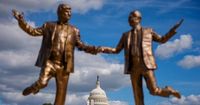In a scene that has captured both the attention and ire of Washington, a controversial statue depicting former U.S. President Donald Trump holding hands with convicted sex offender Jeffrey Epstein has returned to the National Mall, just a week after its abrupt removal by federal authorities. The saga of this towering bronze-painted artwork—standing over 10 feet tall—has become a flashpoint for debates about public art, transparency, and the complicated legacy of both men.
The statue, originally titled “Best Friends Forever” but later renamed “Why Can’t We Be Friends?”, made its reappearance on October 2, 2025, according to The Los Angeles Times and NPR. Its plaque provocatively celebrates “the long-lasting bond between President Donald J. Trump and his ‘closest friend,’ Jeffrey Epstein.” The work, with Trump and Epstein skipping hand-in-hand and kicking up their legs in merriment, was first installed in front of the U.S. Capitol on September 23, 2025, but it was removed less than a day later by the National Park Service (NPS) for not being compliant with its permit, as reported by The Washington Post and The New York Times.
The story behind the statue is almost as dramatic as its subject matter. The artist collective behind the work, a group of anonymous satirical installation artists known as “The Secret Handshake,” has orchestrated several provocative installations around the capital in the past year. According to NPR, the group’s representative stated in an email, “Just like a toppled Confederate general forced back onto a public square, the Donald Trump Jeffrey Epstein statue has risen from the rubble to stand gloriously on the National Mall once again.”
After its initial removal, the statue was damaged—Trump and Epstein’s hands, once joined, were separated, and the figures were torn from their pedestals. Yet, in a feat of artistic resilience, the group managed to restore the artwork almost completely, reuniting the hands and repairing the broken pieces. “They did not want us to put it up, I guess,” said Carol Flaisher, the location manager hired by the artists to navigate the permitting process, as quoted in The New York Times. “But this is the third attempt and it’s up—and it’s still up.”
The bureaucratic back-and-forth over the statue’s display has been labyrinthine. The Secret Handshake initially obtained a permit from the NPS to display the statue through September 28, but U.S. Park Police hauled it away before sunrise on September 24. Subsequent attempts to secure permits were met with sudden revocations and denials, often without explanation. Flaisher eventually discovered that a time-stamped application for a First Amendment demonstration could be automatically permitted after 24 hours if not explicitly denied—a loophole that allowed for the statue’s reinstallation, as detailed by The New York Times.
The Department of the Interior, which oversees the Park Service, said the statue was removed “because it was not compliant with the permit issued,” according to CNN and NPR. The specifics of the non-compliance were never clarified. Meanwhile, the onset of a federal government shutdown on October 1, 2025, further complicated matters, limiting the operations of the National Park Service and leaving agency responses vague or unavailable.
The public’s reaction to the statue has been as varied as the political landscape itself. Photos from the Mall show joggers, dog walkers, and tourists pausing to take selfies with the resurrected monument, reading its plaque, and debating its message. For some, the statue is a bold act of political satire, holding powerful figures accountable through art. For others, it’s an offensive spectacle that reopens wounds related to Epstein’s crimes and Trump’s controversial associations.
Jeffrey Epstein, the financier at the center of the scandal, was arrested by New York law enforcement on July 6, 2019, for arranging for dozens of underage girls to visit his Manhattan home between 2002 and 2005. He died by suicide in his prison cell on August 10, 2019, suspending his criminal prosecution and fueling a storm of conspiracy theories, especially among Trump’s voter base, that he was murdered to prevent him from implicating high-profile figures, as highlighted by AFP and CNN.
Trump’s relationship with Epstein has been the subject of intense scrutiny. While Trump has repeatedly downplayed their friendship, claiming they had a falling out before Epstein’s 2006 indictment—allegedly due to Epstein “poaching employees” from Trump’s Mar-a-Lago spa—critics and the media have continued to probe the extent of their association. The White House, when asked for comment on the statue’s return, issued a statement nearly identical to the one released after its first appearance: “Democrats, the media and the organization that’s wasting their money on this statue knew about Epstein and his victims for years and did nothing to help them while President Trump was calling for transparency, and is now delivering on it with thousands of pages of documents.”
Yet, the Trump administration’s handling of the so-called “Epstein files”—a trove of documents from various investigations into Epstein’s alleged sex-trafficking ring—has been met with widespread criticism. In July, the administration announced it had discovered no new evidence justifying the release of additional documents or the opening of a new investigation. This has not satisfied many lawmakers or members of the public. The House Oversight Committee has subpoenaed and published thousands of pages of documents in its own investigation, while a NPR/PBS News/Marist poll released on October 1, 2025, found that 61% of Americans disapprove of Trump’s handling of the files, with 77% in favor of releasing them with victims’ names removed.
The statue’s presence on the National Mall is permitted through 8 p.m. local time on October 6, 2025, according to NPR. Its future remains uncertain, as does the broader reckoning with the intertwined legacies of Trump and Epstein. For now, the artwork stands as both a lightning rod and a mirror, reflecting the nation’s ongoing struggle with issues of power, accountability, and memory.
As the sun rises over the Capitol, the statue’s provocative tableau continues to draw crowds and spark conversation—a testament to the enduring power of public art to challenge, provoke, and, perhaps, help a society confront its most uncomfortable truths.





